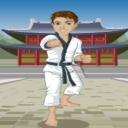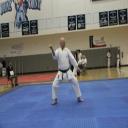Yahoo Answers is shutting down on May 4th, 2021 (Eastern Time) and beginning April 20th, 2021 (Eastern Time) the Yahoo Answers website will be in read-only mode. There will be no changes to other Yahoo properties or services, or your Yahoo account. You can find more information about the Yahoo Answers shutdown and how to download your data on this help page.
Trending News
(opinion) what is the difference between basic and advanced practitioners?
just an opinion question, I want to see what you guys think.
1) what is the difference between an advanced practitioner and a basic practitioner.
2) do you believe that there are advanced concepts to fighting or there is just fighting.
3) what does black belt mean to you. not as a specific rank to any particular martial art or fighting system. but as a level of skill. how would you decide if someone was a black belt regardless of style. (as if there was only white belt and black belt universally)
4) last question so I can know your background and experience. (years trained, major style and if you would like minor styles as well.)
My opinion answers to the questions:
1) for me how well somebody kicks/punches and moves their cardio is all about athleticism and so is something that people can aquire through jogging, stretching, or just being talented. so that isn't enough for me, I think of their ability to perform on a basic level. I think that its not about the techniques that you use but the concepts behind the techniques. the ability to set up, to predict, to exploit each of their movements, to make them move where you want, to redirect focus, and the ability to make the technique work when you want it to regardless of the opponents positioning.
2) I think that anybody can fight on a basic level, the game of tag for instance, without much experience. I also believe that there are advanced strategies and concepts that can be placed to how, when, where, you move or strike. the ability to take an idea and apply it to other areas.
3) black belt to me is when you know the basics, they've become more of a natural reaction then a concious decision, have an idea of other styles, can apply them, defend yourself, a deeper understanding about how and why your style works, and is really working towards more advanced concepts. martial arts is less of hobby and becomes who you are. its also a mindset.
tang soo do and aikido. training 17 years.
liondancer: when I said getting the technique regardless of the opponents positioning, I meant that you have the ability to decide what you want to do and make it work. its more of an expansion on setting the opponent up and getting them to move where you want. you can create the oppening, you put them where you want them. you want to get in a punch to the head for example, that's what you decided and the ability to get them into that positioning, through redirecting, clearing, angeling, however you want. its the ability to make your techniques work. its not the only tool, but one that I think is necessary.
9 Answers
- JayLv 71 decade agoFavorite Answer
This is actually a rather interesting question. I've never tried to put words to these thoughts before. I've always left it to begin at grasping the understanding without the need of words. Chuang Tzu said it best: "The purpose of words are to convey ideas. When the ideas are grasped, the words are forgotten." Martial skill goes beyond idea and into the realm of knowledge and wisdom.
Understanding is an idea; knowledge is experiential understanding; and wisdom is the perfection of that knowledge having been subjected to intense practice.
Now as for your questions:
1) A basic practitioner is someone who is still in the learning process and an advanced practitioner is the perfecting process. We're always still learning but it's not until you have enough experience that you have to begin crafting it into your perfection (everyones "idea" of perfection varies).
2) I believe there are advanced concepts to fighting, however, these are things that the largest majority of the few real practitioners will ever understand. Ultimately fighting is fighting, but there can be a huge gap in the skill level between the two. People can set their sites too low and refuse to think beyond their current means and label anything outside of the sphere of their knowledge as fake nonsense. Most people never take that journey to find out if it is or not on their own through legitimate means. I see it countlessly here on Y/A, but that's okay. Everyone has their own place where they want to be.
3) I see belt ranks like I see standard education. Grade School = kyuu ranks, High School = first few dan ranks, College = last few dan ranks. By the time your ready to go out and face the real world you're prepared for anything and everything... hopefully. Not all schools are the same so hopefully you got into a good one.
4) I've trained in several different arts and have carried many methods with me from other areas. My main focus is in Goju Ryu and Hapkido. I took Goju Ryu for 8 years and made it to nidan. Hapkido for 7 years, I'm currently at shodan ready for nidan. (Testing in January)
I've studied Shotokan with Chun Do Kwan Taekwondo mixed in (6 years, during the same time as Goju - made it to shodan). I also practice techniques from Judo, Aikido and Taijiquan in Hapkido. I've also learned Hung Gar Kuen (informally). I've also picked up on Chang Chaun, Shaolin Gongfu (namely Lui He Quan, Luohan Quan and Mei Hua Quan), Bajiquan, Xing Yi Quan, Chin Na and Mew Hing's 18 Taoist Palm (an Iron Palm system). These I don't really know how long, but they've all been in the last 6 years. I also practice some that aren't a complete style but parts of one like Chin Na, such as Dim-Mak and Qigong.
I've also trained in Kobudo, and quite a bit of different staff forms (Chinese and Okinawan). My Kenjutsu training is in Kashima Shinden Jikishinkage Ryu (6 years) and Toyama Ryu Battojutsu (4 years).
I also practice Taoist and Yatha Yoga (6 years).
I hope that gives you what you're looking for.
- ?Lv 61 decade ago
Pugpaws is absolutely right -- these are each a whole question in their own right. I'm going to attempt to give short answers, but know they don't do the question justice.
1.) Fundamentally, experience. The only difference between a beginner and advanced practitioner is the wisdom to apply what they've learned, and how. Shihan J gives a great example of this in learning how to avoid the fight.
2.) I believe the most advanced principle of fighting is... What's the easiest way to put this... "0". To simply not be there, wherever there may be: physically, emotionally, mentally, spiritually. You have to learn to create a void in the opponents perception. So, yes, I do believe there are advanced concepts.
3.) It keeps the keikogi from flying open. I'm working on my white belt now. I don't worry about others rank. Just their ability.
4.) Gah... 22 years, sporadic, as of next may. Primary style: Taijutsu.
Source(s): Bujinkan Budo Taijutsu http://ocbujinkan.com/ - LiondancerLv 71 decade ago
1) Quote: "the ability to make the technique work when you want it to regardless of the opponents positioning."
This is exactly what makes a beginner! An advanced martial arts practitioner would be able to adjust quickly to the opponent take what the opponent gives and redirect the foce by countering with an appropriate technique. If you do what you describe it becomes a power struggle and is not a martial art anymore.
2) See number one
3) See number one
20 years martial arts training and still learning. Karate, Chen Tai Chi (fighting art not stretching exercise), little Kung Fu and lion dance and very little Aikido and Judo.
- Leo LLv 71 decade ago
An advanced practitioner is one who has the ability to use the techniques in the way they were intended. traditionally, this would equate to first Dan (discounting McDojos).
There are advanced fighting concepts. These include strategies and techniques. A basic fighter will tend to move forward and backwards only, for example. As we develop, we learn to move in all directions, slanting in and out.
A black belt is a serious student, one who has acquired basic proficiency and is working to learn more.
I have trained in TKD for just over 16 years. I have no desire to learn another art, although I have trained in some weapons and would enjoy doing more. I have also had some self defense training that is not, strictly speaking, TKD. I find this helpful, because it gives me an alternative to a hard, TKD style, block and it is fun to learn new stuff. All this additional training has come from the TKD school, so it was intended to compliment barehanded TKD.
- How do you think about the answers? You can sign in to vote the answer.
- Anonymous1 decade ago
1) Knowledge and time spent studying. The ability to execute any technique with ease, skill, and proper body mechanics. The ability to articulate the principles of any technique's execution.
2) There is just fighting. Advanced concepts are just ways of better understanding body mechanics, and come with time. They could be considered as advanced concepts, but they are as simple as 1+1=2. They just need to be learned and understood as such.
3) That skill level is where the student is able to execute basic techniques with proficiency, and has the ability to understand and employ the concepts taught down the line ('advanced concepts').
4) 20 years martial arts experience in a plethora of styles. Primarily Shurite Karate Jitsu and Chen Taijiquan
- Karate DaveLv 61 decade ago
1)This will be very over simplified but: You are advanced when the best technique for the situation is what comes to action as a reflex vs thinking of a technique and then making the situation work for it.
2)Yes there are advanced concepts for self defense. Martial arts are not about fighting, they are about ending the confrontation quickly and effectively by any means necessary, be that diffusing the situation through dialog or taking physical action up to and including killing or maiming your attacker.
3)I would have to agree with your basic definition of a black belt
4) I have studied Chung Do Kwan, Kajunkenbo, and Shotokan. I have worked out with / associated with with practitioners from various Kung Fu , and Goju Ryu, Isshin Ryu, Moo Duk Kwan, Wing Tsun schools. I have been in the martial arts for 29+ years.
- pugpaws2Lv 71 decade ago
Derek,
I could write a small book on just your first question. I think that if you really want complete answers you should ask each of these as its own question. If you do, I'll try to answer them as completely as I can. But as the question stands. It would take me an hour to type it. Having never learned to type, it takes a long time to write answers.
EDIT: **********
Here is a short answer to the first question.
Basic and advanced students of the martial arts.
A basic student can be anyone from someone taking their first lesson to someone of good physical skills. Advanced is a relative term. To many people, anyone who has a blck belt is an advanced practitioner of their art. To the Japanese, a Black belt is just beginning to leanr the art. So he is not an advanced practitioner. In learning the martial arts there is first of all the memorization of the techniques and developing the physical skills. This takes a long time as the mind and body have to learn and be able to do these without hesitation. There is muscle memory and mental linking that only much practice can provide. The physical skills are daunting to become very good. But this is only the tip of the iceberg. Advanced practitioners of an art are able to understand the techniques and principles of the art on an intuitive level. They understand how and why the techniques work. They have much more than just good techniques, Kata, and fighting skills. An advanced student understands the techniques so well that he can easily modify them in mid motion. He is able to instantly come up with many variations of a technique based on his understanding fo the principles, balance, distance, ...etc.
A basic student learns everything exactly one way. They have a set block for a particular attack. As such, that mindset is flawed and doomed to be limited in scope. If you have to have a different response to every variation of possible attacks, the number of techniques needed would be impossible to learn. Even if it was possible to learn the thousands of techniques, you could never develop them all to a level of efficiency that would be usable in all situations. Beside that, it would be impossible to instantly recall the right response to ever attack that is possible. In other words if someone attacked with something unusual, you are likely to freeze or not be able to recall the correct response in time to defend yourself.
Advanced practitioners understand the principles that can describe any possible attack a human can use not matte what fighting style he uses. In my style for example there are only 12 principles to describe the techniques of any style or method of fighting. We are taught the principles to analyze the attacking technique and to instantly know the correct one or more of the 12 principles that will defeat the attack. It is kind of like the game, Rock, Paper, Sissors.
Once a student reaches a high level of physical skills (balance, speed, technique, timing,............) He is not an advanced student or master until he can instantly respond to an attack by using the 12 principles. In other words, in stead of having to learn and try to develop thousands of techniques, he has to be able to recognize any movement (his or the attacker) and use any technique that uses the correct principle. Just like the game, Rock can break Sissors. The type of technique that is used is irrelevant, as long as it is one that uses the correct principle.
A short simple example of this is....
Attacker attempts a spinning back kick. Many people would try to block or move away. We see the kick as a circle. The power is at the foot. The closer to the center of rotation (The persons body) the less damage the kicks can do. We see this attack as simply a circle. A line can defeat a circle. So we simply move nito the attacker quickly and bump his pelvis with ours. We are now inside the kick. We have evade the kick by moving into the center of the circle before the kick can hit us. We have basically used a line to defeat a circle. We have also demonstrated the three rules of engagement that I drill into my students. That being Re-direct, Distract, Off balance. In this case we have evaded the kick instead of re-directing it. We have off balanced the attacker by bumping into him. Finally we have also distracted him since he knows his kick failed and we are on top of him in control. As long as we don’t stop, we have the attack under control in our first response.
...
...
Source(s): Martial arts training and research since 1967. Teaching martial arts since 1973. - Frank the tankLv 71 decade ago
1) The amount of knowledge
2) There are advanced concepts of fighting, which you develop and are able to understand with time.
3) You've mastered the basics.
Source(s): my brain ;) - KokoroLv 71 decade ago
-when you realize the mistake you made can also be used in the situation your in, and there are no mistakes, it all just flows in to the right movement.
-you don't have to resort to violence to win







